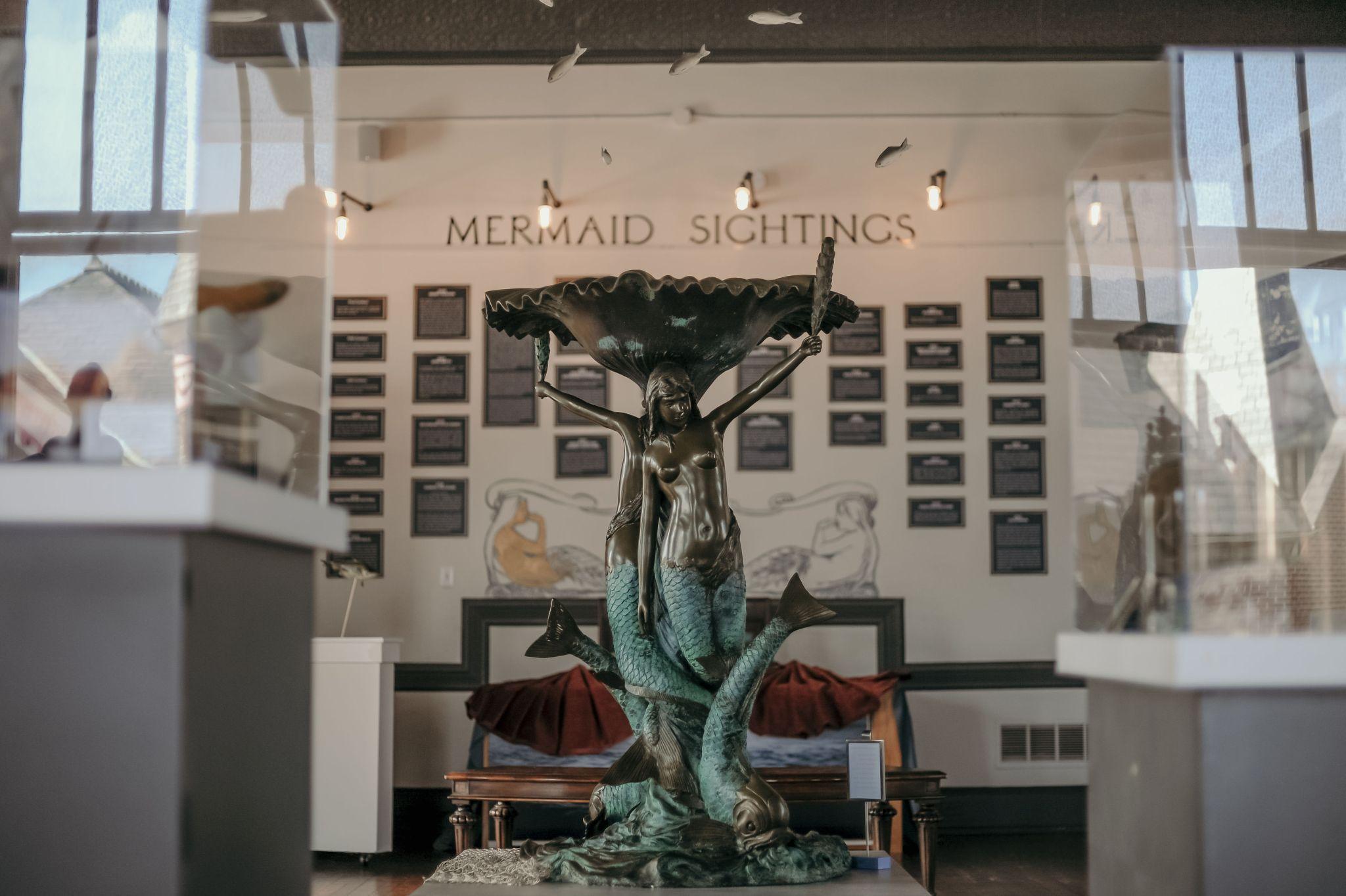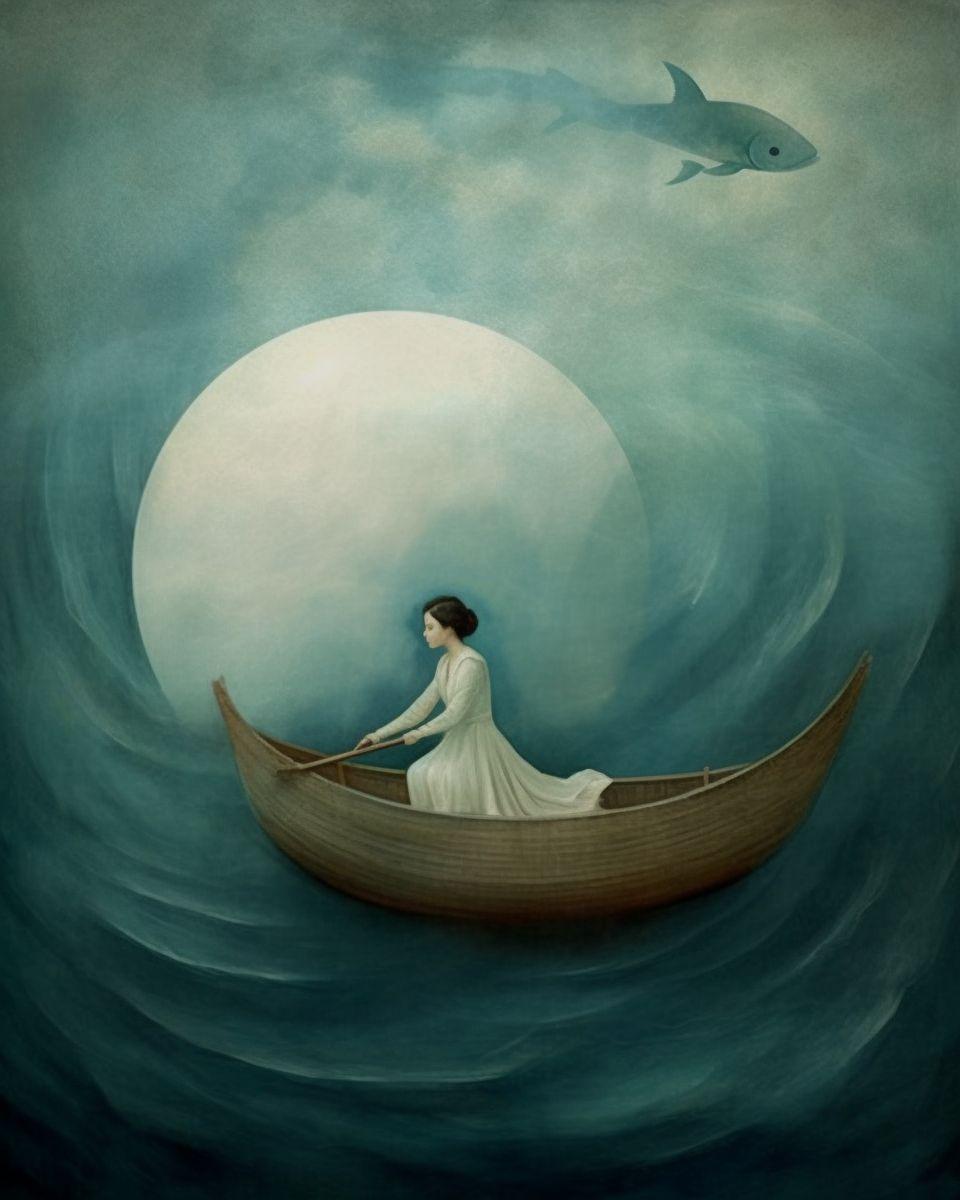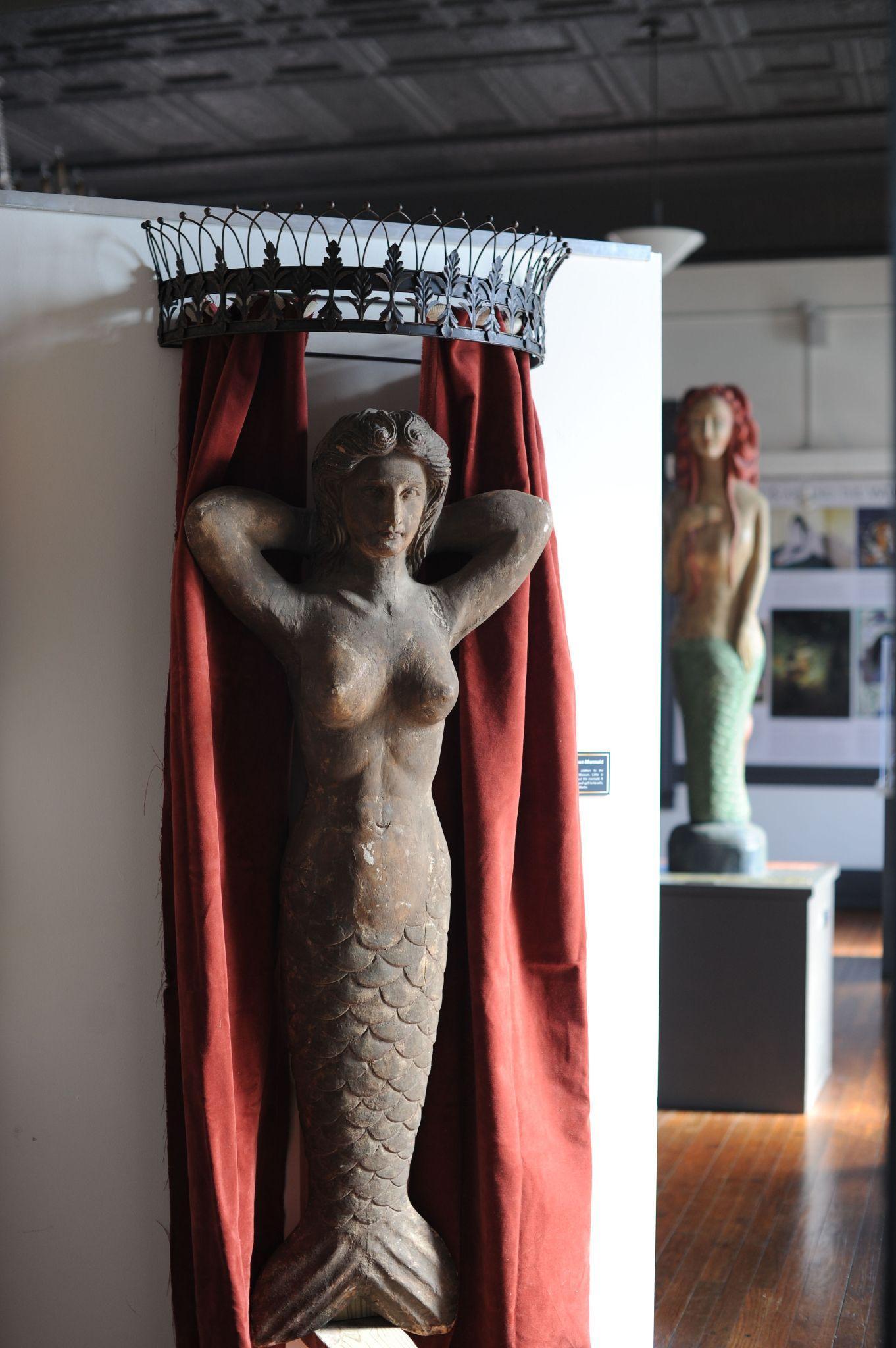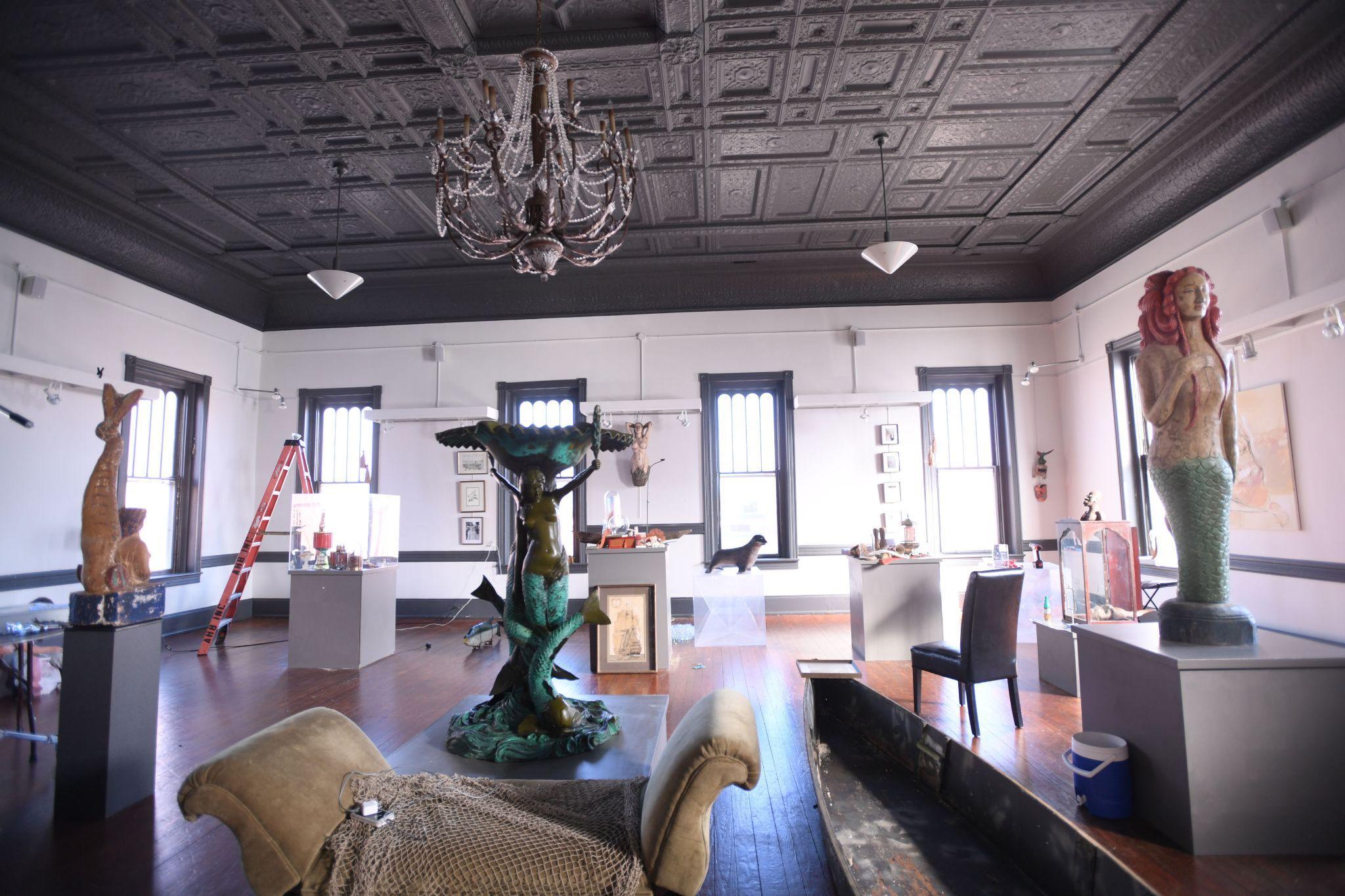
4 minute read
THE MERMAID MUSEUM

The ocean’s notorious femme fatale is the muse
Advertisement

by laren stover
By 18 she had two mermaid tattoos. Alyssa Maloof, a photographer and founder of The Mermaid Museum says, “I didn’t have a collection, or think about them all the time, but a mermaid tattooisaprettyserioussignthatIwasgettingthesiren’scallthroughtheether.”
Alyssa’s photo studio, the airy second floor of a former Odd Fellows building in Berlin, Maryland,waslargelydormantin2020.Sowhenvisionsofmermaidsbegantoswiminherhead,she came up with the idea to install a mermaid museum in the space. What clinched the deal was not a vision of a beguiling sea maiden with sea-green eyes and seaweed-laced hair. What glamoured her wasnotevenaselkie.
“As I was musing about making the museum, I was early to a wedding I was shooting in Philadelphia so I walked intoAnastacia’s, my favorite antiques shop back when I was an art student. Itwasalwaysadreamtobeabletobuyabigthingfromthere.
“‘Do you have anything mermaid oriented?’ I asked the owner and he said, ‘Oh, yeah, we havealittledish.’Thenhepointedtoaglasscaseveiledindustandsaidwarily,‘Wealsohave that.’”

That turned out to be a “preserved” mythic creature. Resting on a bed of sand with a fan-coral backdrop and a few scattered shells was a genuine Fiji mermaid. The upper half, a delicate mummified scaly bony body with a grimacing skull and bulging glass eyes and outstretched arms clutching a starfish—the bottomhalf,ataxidermyfishtail.
“And that was the moment I asked myself, am I really going to spend $4,000 on a dried-up mermaid?”
Alyssa did have a ship’s figurehead of a mermaid, but this was a true curiosity, a rare treasure witharare-treasureprice.
She drove back to Berlin haunted by the P.T. Barnum-era relic for a week. (P.T. Barnum unveiled a similar “FeeJee” mermaid in New York in 1842, allegedly fashioned by a Japanese fisherman by melding a monkey and fish.) She was ultimately hooked by the creature, an acquisition that made her commit to the museum. “I drove back up, put her in thebackofmycar,andIsaid,Pleasedon’tcurseme.”
The Mermaid Museum, nine miles from the sea where wild ponies roam the beaches and dunes of Assateague, is a dreamy loft with tall windows and a high ceiling. When you enter, you are instantly transported by otherworldly music wafting through the exhibits that illustrate fantasy and folklore alongside nautical lore and science, and by science, the evidence uncovered here is truly the most whimsical kind of scientificevidence.
The museum is a crash course in mermaid history and lore, but seductively interactive—as soon as you enter you encounter a trunk spilling over with mermaid and sailor costumes so you can dress up and lounge in a giant clam shell for a selfie, or show off your mermaid tail in an antique tub, and you’re also invitedtodrawmermaidsonawall.

Mermaids lure you from all over the room: an immense hand-carved red-headed sea siren welcomes you (or do we mean warns you?) as you enter, a brass fountain of two alluring mermaids balancing a giant shell on their heads beckons with gentle sprays of water, and you may be mesmerized by a silent 1904 film La Sirène by George Méliès projected onto an entire wall as a magician scoops fish from his top hat, manifestsamermaidandthentransformsherintoamaidenwithlegs.
Tiny peepholes, eye level for a child, offer magical scenarios and surprises: tiny jellyfish or a glass globewithamermaidhologramortheanswertothequestion:Whoistheworld’smostfamousmermaid?
Ariel…ofcourse.
The walls and cases and bell jars tell stories, all researched, compiled and written in a tidal wave of inspirationbyAlyssaoversixmonths.Shedroppedoffheryoungsonwithhermother,rentedahotelroom in nearbyOceanCityandsatonthebeachwritingwithcopiousnotesandbookstotherhythmofthesea.

Inspired by the Jurassic Museum of Technology, in Culver City, California, a mixture of artistic, scientific, ethnographic, and historic items which have been said to evoke a cabinet of curiosities which predates the modern natural history museum (as per Wikipedia), The Mermaid Museum is diverse and playfullyhistoricinitsstorytellingandrangeofartifacts.
The overall effect is one of almost-credible fantasy laced with artistry and whimsy supported by well documentedeyewitnessaccountsfromsailorsandseacaptainsfromallovertheworld:ChristopherColumbus in 1493 reported that he saw three mermaids frolicking in the water writing that “they were not as beautiful as theyarepainted,althoughtosomeextenttheyhaveahumanappearanceintheface…”

And there are also accounts from a famed English sea explorer, a Welsh farmer, a Danish reverend, dam workers in Zimbabwe, Japanese soldiers, fishermen in Cape Breton, Canada, and even an alleged sighting in Fresno, California, where a lost woman with webbed feet claimed to be a mermaid and to have comefromanearbylake.
We learn from a wall plaque that Pliny the Elder wrote about nereids in the first century, describing themaswomenwithscalybodieslikefish,amythicalprecursortomermaids.Afifth-centurybestiary(a study ofanimalsandtheirnatures)called Physiologus, describedmermaidsashavingtheupperhalfofawomanand the lower of a fish, split at about the navel. In the 13th century, a Franciscan monk Bartholomeus Anglicus, wrote De proprietatibus rerum (On the Properties of Things) and described the mermaid as a femme fatale stealingsailorsfromtheirships.
Mermaidsandwaterspirits,infact,arefamousfordrowningmen.TheRusakla,aRussianmermaidor the soul of a young woman who has drowned, would lure young men into the water where she’d entangle her victims’feetwithherlongredhairorticklethemtodeathasshelaughed.
Depending on who is describing her, the appearance of the notorious femme fatale shifts—her hair goesfromblacktolightbrowntoblondetoredtogreen,butsheisalwayselusive.
They rarely fare well, however, when captured. In 1560, the aide to the Viceroy of Goa performed autopsies autopsies on seven mermaids caught by fishermen in Ceylon. A Dutch artist named Samuel Fallours (who worked on Ambon Island) claimed to have acquired one and kept her in a container of water and painted her. She squeaked like a mouse, he said, and died of starvation as sherefusedtoeat.
In a display of a bisque figurine and photo of mermaid bones, we read that “Mermaids in Japan are more commonly known as Ningyo. The skeletal remains ofamermaidcanactuallybefoundondisplayatRyuguji temple in the city of Fukuoka, the specimen allegedly dates back to the 13th century and was found when it washed ashore in Hakata Bay on the Japanese Island of Kyushu.LongagovisitorstoRyūgū-Ukimidoweregiven water to sip in which the ‘mermaid bones’ had been soaked,allegedlytoprotectthemfromdisease.”
Walkingthroughthemuseumwefindanamusing fashion fashion fact, that mermaids almost always went topless until 1946 when Parisian designer Jacques Heim showedthefirstbikinicalledtheAtome.

There are mermaid cameos, Vintage Weeki Wachee memorabilia, a very realistic “preserved” mermaid embryo nestled in sea sponges. In a cultured pearl display, we learn that “mermaids kept oystersaspetsandwithintheoysterstheygrowpearls.”Andwhoknewthatthemermaid’sfavoritegem isopal,andwasespeciallypopularamongmermaidsinMedievaltimes?


There’stheVirginMermaidfishinglurethatpromisestolurebothmenandfish. Didsailorsmistakesealsandmanateesformermaids?
Alyssamuses,“Seaweary?Drink?”
What is the eternal allure of the mermaid? Alyssa goes deeper than the glamour of the sea’s notoriousfemmefatale:
“I think the mystery of the ocean—the juxtaposition between life and destruction is a metaphor for the mermaid…the ocean is freeing when you’re actually swimming and you feel so alive, how you can float and feel free. But it’s also scary because the ocean can easily take your life, and there’s so much that we can’t see under there that the idea of the mermaid strikes something in our subconscious aboutthedepthsofourwanderings.”

WhatisAlyssa’smostprizedpossessioninthemuseum?
“A Cheeto in the shape of a mermaid,” says Alyssa. “I found it on eBay for $1.00 with $3.99 shipping.”











